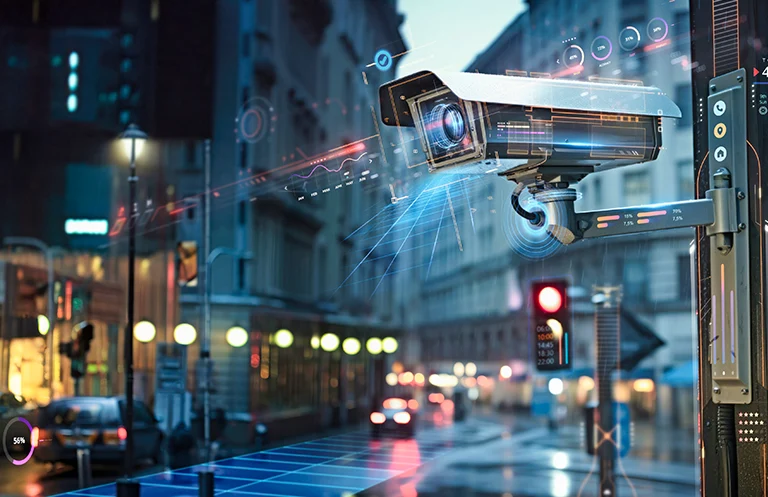Introduction
The Internet of Medical Things (IoMT) is leading a revolution in the healthcare industry and promises to make healthcare more efficient, individualized, and easily accessible.
Just imagine living in a future where intelligent devices continuously monitor and combine all the health information such as heart rate and sleep habits into a system of healthcare. It is a revolutionary approach to preventive medicine. By utilizing the capability of IoMT, medical professionals can identify any health-related problem before it gets worse or becomes a serious issue. According to Grand View Research, the IoT in the healthcare market is estimated to reach $169.99 billion by 2030.
The history of IoMT starts from a simple medical device that functioned on its own and whose work was to give minimal data. However, as technology developed, these devices gained intelligence and connected to a network. This modification led to remote patient monitoring and predictive analytics.
What are IoMT devices?
The Internet of Medical Things (IoMT) is the term used for smart medical devices used in healthcare and allows to gather, transmit, and receive data. IoMT devices use a secure network to communicate information between patients, clinicians, and medical devices. IoMT encompasses a wide range of intelligent medical devices, such as point-of-care devices, remote patient monitoring, wearable smart devices, clinical monitoring setups, and smart pills.
Rise of IoMT devices in healthcare
Due to the rising aging population and chronic diseases, the demand for remote monitoring solutions is witnessing a spike. In addition, the soaring healthcare costs and increased consciousness towards individual health have sparked the boost of IoMT devices in the healthcare ecosystem.
IoMT and the Connected Healthcare Ecosystem
IoMT devices create a connected healthcare network by facilitating the continuous flow of patient data. The range of interconnected medical devices continuously collects health data from patients via sensors. This data may include vitals, medication usage, sleep patterns, and activity levels. The data collected is securely transmitted to the cloud through network technology such as Wi-Fi, ZigBee, Bluetooth Low Energy, Local Area Networks, etc. Using advanced data analytics, the data can be analyzed to uncover valuable insights and patterns to offer quality care. IoMT devices enable healthcare providers with real-time access to patients’ data, facilitating remote patient monitoring.
Significance of Connected Healthcare
Connected healthcare is the umbrella term for the delivery and management of healthcare services focused on self-care and remote care. It eliminates the need for in-person visits by allowing healthcare providers to have real-time access to patient health data. Connected healthcare is making remote and at-home diagnosis a reality, extending the horizon of doctors beyond the four walls of the hospitals. Advancements in technology and rapidly evolving Internet of Things technologies are contributing to the accelerated growth of connected healthcare. Connected healthcare is transitioning the whole healthcare delivery model and shifting towards a more patient-focused and value-based care approach.
The connected healthcare ecosystem offers numerous benefits for patients and healthcare providers. Patients have better access to care from the comfort of their surroundings with telehealth systems. Hospitals can improve resource efficiency with remote monitoring using IoMT devices for chronic patients and devote in-person resources to acute cases. Wearable devices and at-home diagnostics systems provide enhanced patient. Connected is the core of the future healthcare systems. People want to actively participate and take control of their health, while patients are seeking accessible and affordable healthcare. Connected healthcare enables a proactive healthcare system with IoMT devices.
Advantages of IoT- connected Medical Devices to Patient
Patients demand better experiences, including more power over their health, more transparent contact with healthcare providers, and easier accessibility to care services. Reshaping the patient’s experience is a difficult process that requires a variety of ways, one of the most promising of which is the use of IoT in healthcare.
- Continuous Remote Monitoring Gives Real-Time Data
Healthcare practitioners can continually track a patient’s well-being without being present in the same room by using Internet of Things (IoT) devices that can transmit data in real time. Elderly patients can be watched remotely from their homes, while hospitalized patients can have more time to unwind or relax without someone physically present. In both circumstances, the patient receives the same level of care but with more flexibility.
- Simplified Interaction Between Patients and Doctors
Connected devices can send health data in real-time to healthcare specialists, allowing for online consultations and telemedicine sessions. Patients can confidentially discuss their signs, symptoms, advancement, and worries with their medical providers, allowing them to provide right away feedback, guidance, and treatment plan revisions. This real-time communication strengthens patient-provider connections, shortens response times, and promotes more tailored care delivery.
- Smarter Building Modifications Provide a More Comfortable Atmosphere
The Internet of Things can also be used in subtler ways, yet with significant results. For example, a hospital could utilize RFID tags to track and handle supplies and equipment, allowing the facility to be more organized and ensuring staff have whatever they require to care for patients.
- Intelligent Sensors Generate Faster Notification for Medical Workers
Intelligent sensors that monitor patients’ vital signs and promptly notify medical workers of an issue could save lives. This not only means quicker care in the case of a medical emergency but also peace of mind in the absence of one.
These sensors, which can also be utilized for patient monitoring, can use algorithms to assess real-time data, warn nurses or doctors, and offer recommendations for the next actions.
- Accurate and Convenient Diagnostics
Medical conditions can be diagnosed at an earlier stage thanks to sophisticated IoT diagnostic devices such as ingestible robots for digestive system examinations or portable Electroencephalogram (EEG) headsets, which improve accuracy and patient comfort. It’s important to note that such devices assist in detecting patterns that were previously unknown to caregivers, contributing to the research and diagnoses of rare conditions and increasing treatment success rates.
Advantages Of IoT-Connected Medical Devices to Healthcare Industry
Patients and healthcare professionals are witnessing a paradigm shift with the smooth integration of IoT devices and applications. The development of the Internet of Things brings beneficial transformation for the healthcare industry, such as
- Improves Hospital Efficiency
The Internet of Things (IoT) in healthcare can monitor both regular and minute facts about a patient’s health. Aside from this, IoT improves the healthcare industry’s performance. Asset management is one of the topics. Wheelchairs, oxygen pumps, nebulizers, defibrillators, and other monitoring devices are tracked frequently to ensure their real-time whereabouts. The IoT sensors attached to them allow hospital administrators to monitor their real-time position in a matter of minutes. Medical personnel need to be present at various locations, and their deployment can be tracked easily.
- Smooth Insurance Claims Process
The ever-expanding healthcare policies, combined with IoT connectivity, are certainly one of the coming big things. Why? This is because numerous people claim to have health concerns to redeem their covered money with the greatest possible benefits. It results in an inconvenience for the insurance company. With accurate IoT-driven data through health monitoring devices, insurance companies can use the information to claim and underwrite operations. Fraud claims could be easily detected using such systems.
- Accelerates Medical Research
Medical research takes years, and the Internet of Things can help reduce time. The medical condition information is very helpful in this, as it can be employed in statistical analyses. Thus, the Internet of Things saves not only time but also money, allowing for larger and improved medical research and treatments.
Applications of IoMT Devices in Healthcare
Picture a world where medical devices are not just tools but intelligent companions that actively participate in the healthcare journey. This is the realm of the Internet of Medical Things (IoMT), where a myriad of connected devices work in harmony to elevate patient care, optimize medical processes, and unlock new frontiers in healthcare efficiency. Here are some of the most prominent applications of IoMT devices in healthcare:
MRI and CT Scanners
IoMT-enabled MRI and CT scanners allow remote monitoring, control, and maintenance, providing healthcare professionals with real-time data access and settings adjustment. Embedded systems in these scanners use radio frequency pulses and X-rays to produce detailed pictures of body parts and internal structures, exemplifying the application of embedded systems in medical devices.
Blood Pressure and Glucose Monitoring Devices
Connected blood pressure devices and glucose monitors, powered by embedded systems, allow patients to conveniently track their vital signs and blood sugar levels from home.
These devices efficiently detect systolic and diastolic pressure and test sugar levels, collecting crucial health data that is automatically transmitted to healthcare providers. This enables remote monitoring and facilitates early intervention when necessary, showcasing the significance of embedded systems in healthcare.
Connected Inhalers
IoMT-enabled smart inhalers assist patients with respiratory conditions by tracking medication, providing dosage reminders, and offering usage guidance through connected apps. Sensors monitor breathing patterns and alert doctors to potential issues, enabling personalized treatment adjustments.
These devices improve medication adherence and provide valuable data to healthcare providers. Connected Inhalers also enhance the management of conditions like asthma and COPD by optimizing care plans.
Fitness Trackers
Fitness trackers, while not strictly medical devices, have gained popularity in healthcare. These IoMT devices monitor various health metrics, such as heart rate, sleep patterns, and physical activity. They provide valuable insights into a patient’s overall health and well-being.
Although not as accurate as medical monitoring systems, fitness trackers can help with the early identification of health conditions and empower people to take control of their health.
Patient Remote Monitoring
IoMT devices have revolutionized patient remote monitoring, especially for those with chronic conditions or recovering from surgery. Wearable ECG monitors, pulse oximeters, and other connected devices allow healthcare providers to monitor patients’ vital signs remotely. This reduces the need for frequent hospital visits and enables early detection of potential complications.
The integration of IoMT devices in healthcare has the potential to:
- Significantly improve patient outcomes
- Reduce healthcare costs
- Enhance the overall quality of care
As technology advances, we can expect to see even more innovative IoMT applications in the healthcare sector.
Conclusion
The Internet of Medical Things (IoMT) is not just a technological advancement; it is a transformative force that is redefining the healthcare landscape. By enabling more efficient, personalized, and accessible care, IoMT is empowering patients, healthcare providers, and the entire healthcare ecosystem to achieve better outcomes. As we witness the rapid integration of IoMT devices in various aspects of healthcare, from remote monitoring to advanced diagnostics, it becomes evident that this revolution is just the beginning.
The question that arises is, how can healthcare organizations and professionals harness the full potential of IoMT to drive innovation, improve patient experiences, and ultimately, save lives? The answer lies in embracing change, investing in the right technologies, and fostering a culture of continuous learning and adaptation. As we stand at the precipice of a new era in healthcare, it is up to us to seize the opportunities presented by IoMT and shape a future where healthcare is not just a service, but a seamless, data-driven, and patient-centric experience.
Are you ready to be a part of this transformative journey and lead the way in the IoMT revolution?













